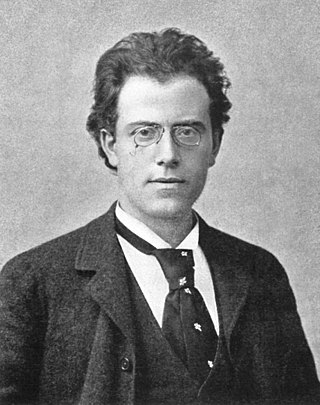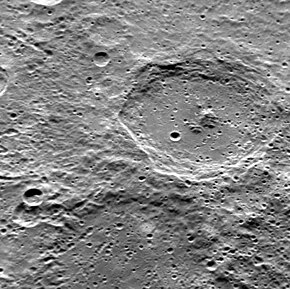
Gustav Mahler was an Austro-Bohemian Romantic composer, and one of the leading conductors of his generation. As a composer he acted as a bridge between the 19th-century Austro-German tradition and the modernism of the early 20th century. While in his lifetime his status as a conductor was established beyond question, his own music gained wide popularity only after periods of relative neglect, which included a ban on its performance in much of Europe during the Nazi era. After 1945 his compositions were rediscovered by a new generation of listeners; Mahler then became one of the most frequently performed and recorded of all composers, a position he has sustained into the 21st century.

Bruno Walter was a German-born conductor, pianist and composer. Born in Berlin, he escaped Nazi Germany in 1933, was naturalised as a French citizen in 1938, and settled in the United States in 1939. He worked closely with Gustav Mahler, whose music he helped to establish in the repertory, held major positions with the Leipzig Gewandhaus Orchestra, New York Philharmonic, Concertgebouw Orchestra, Salzburg Festival, Vienna State Opera, Bavarian State Opera, Staatsoper Unter den Linden and Deutsche Oper Berlin, among others, made recordings of historical and artistic significance, and is widely considered to be one of the great conductors of the 20th century.

The Chicxulub crater is an impact crater buried underneath the Yucatán Peninsula in Mexico. Its center is offshore, but the crater is named after the onshore community of Chicxulub Pueblo. It was formed slightly over 66 million years ago when a large asteroid, about ten kilometers in diameter, struck Earth. The crater is estimated to be 180 kilometers in diameter and 20 kilometers in depth. It is the second largest confirmed impact structure on Earth, and the only one whose peak ring is intact and directly accessible for scientific research.

The Symphony No. 8 in E-flat major by Gustav Mahler is one of the largest-scale choral works in the classical concert repertoire. As it requires huge instrumental and vocal forces it is frequently called the "Symphony of a Thousand", although the work is normally presented with far fewer than a thousand performers and the composer did not sanction that name – actually, he disapproved of it. The work was composed in a single inspired burst at his Maiernigg villa in southern Austria in the summer of 1906. The last of Mahler's works that was premiered in his lifetime, the symphony was a critical and popular success when he conducted the Munich Philharmonic in its first performance, in Munich, on 12 September 1910.

The Symphony No. 4 in G major by Gustav Mahler was composed from 1899 to 1900, though it incorporates a song originally written in 1892. That song, "Das himmlische Leben", presents a child's vision of heaven and is sung by a soprano in the symphony's Finale. Both smaller in orchestration and shorter in length than Mahler's earlier symphonies, the Fourth Symphony was initially planned to be in six movements, alternating between three instrumental and three vocal movements. The symphony's final form—begun in July 1899 at Bad Aussee and completed in August 1900 at Maiernigg—retains only one vocal movement and is in four movements: Bedächtig, nicht eilen ; In gemächlicher Bewegung, ohne Hast ; Ruhevoll,poco adagio ; and Sehr behaglich.

The Symphony No. 2 in C minor by Gustav Mahler, known as the Resurrection Symphony, was written between 1888 and 1894, and first performed in 1895. This symphony was one of Mahler's most popular and successful works during his lifetime. It was his first major work that established his lifelong view of the beauty of afterlife and resurrection. In this large work, the composer further developed the creativity of "sound of the distance" and creating a "world of its own", aspects already seen in his First Symphony. The work has a duration of 80 to 90 minutes, and is conventionally labelled as being in the key of C minor; the New Grove Dictionary of Music and Musicians labels the work's tonality as C minor–E♭ major. It was voted the fifth-greatest symphony of all time in a survey of conductors carried out by the BBC Music Magazine.

Alma Mahler-Werfel was an Austrian composer, author, editor, and socialite. Musically active from her early years, she was the composer of nearly fifty songs for voice and piano, and works in other genres as well. 17 songs are known to have survived. At 15, she was mentored by Max Burckhard.

The far side of the Moon is the lunar hemisphere that always faces away from Earth, opposite to the near side, because of synchronous rotation in the Moon's orbit. Compared to the near side, the far side's terrain is rugged, with a multitude of impact craters and relatively few flat and dark lunar maria ("seas"), giving it an appearance closer to other barren places in the Solar System such as Mercury and Callisto. It has one of the largest craters in the Solar System, the South Pole–Aitken basin. The hemisphere has sometimes been called the "dark side of the Moon", where "dark" means "unknown" instead of "lacking sunlight" – each side of the Moon experiences two weeks of sunlight while the opposite side experiences two weeks of night.

Lunar craters are impact craters on Earth's Moon. The Moon's surface has many craters, all of which were formed by impacts. The International Astronomical Union currently recognizes 9,137 craters, of which 1,675 have been dated.

Horst Mahler is a German former lawyer and political activist. He once was a far-left militant and a founding member of the Red Army Faction who later became a Maoist, before switching to neo-Nazism. Between 2000 and 2003, he was a member of the far-right National Democratic Party of Germany. Since 2003, he has repeatedly been convicted of Volksverhetzung and Holocaust denial, and he served much of a twelve-year prison sentence.
In convex geometry, the Mahler volume of a centrally symmetric convex body is a dimensionless quantity that is associated with the body and is invariant under linear transformations. It is named after German-English mathematician Kurt Mahler. It is known that the shapes with the largest possible Mahler volume are the balls and solid ellipsoids; this is now known as the Blaschke–Santaló inequality. The still-unsolved Mahler conjecture states that the minimum possible Mahler volume is attained by a hypercube.

Hitomaro is a crater on Mercury. It has a diameter of 105 kilometers. Its name was adopted by the International Astronomical Union (IAU) in 1976. Hitomaro is named for the Japanese poet Kakinomoto no Hitomaro, who lived from the 650s to roughly 709.

Kenkō is a crater on Mercury. Its name was adopted by the International Astronomical Union (IAU) in 1976. Kenko is named for the Japanese author Yoshida Kenkō, who lived from 1283 to 1352.

Mahler on the Couch is a 2010 German film directed by Percy Adlon and Felix Adlon. It is an historical drama depicting an affair between Alma Mahler and Walter Gropius, and the subsequent psychoanalysis of Mahler's husband Gustav Mahler by Sigmund Freud.
Gustav Mahler (1860–1911) was a Romantic composer.















